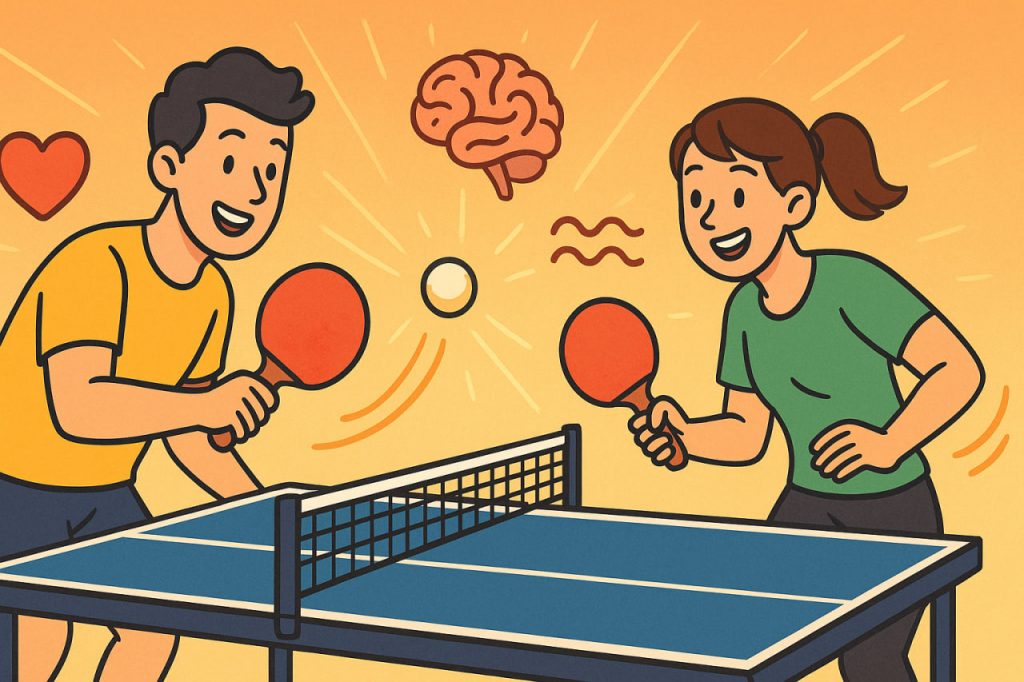Table tennis, also known as ping pong, is more than just a fun pastime — it’s a scientifically proven way to enhance both physical fitness and mental sharpness. Played by millions around the world, it combines quick reflexes, strategic thinking, and full-body coordination in a compact, accessible form. Whether played recreationally or competitively, table tennis offers an excellent balance of exercise, brain stimulation, and social engagement.
A Perfect Workout for All Ages
Table tennis is often described as a low-impact, high-intensity sport. The game involves constant movement — short sprints, twists, and rapid reactions — that keep the cardiovascular system active without putting stress on joints.
Regular play helps improve:
- Cardiovascular endurance by increasing heart rate.
- Flexibility and coordination, as players constantly adjust their stance.
- Balance and agility, through quick changes of direction.
- Muscle tone, particularly in the legs, arms, and core.
Even short matches provide effective aerobic activity, comparable to brisk walking or light running, making it ideal for people of all ages — from children to seniors.
Enhancing Brain Function and Reflexes
One of the most remarkable benefits of table tennis lies in its impact on the brain. Because players must process fast-moving visual information and respond instantly, the sport enhances reaction speed, hand-eye coordination, and concentration.
Neuroscientists have even found that table tennis stimulates multiple regions of the brain simultaneously — including those responsible for strategic thinking, planning, and focus. This makes it beneficial for improving cognitive performance and maintaining mental sharpness with age.
In countries like Japan and Germany, table tennis is used in senior centers and rehabilitation programs to help reduce cognitive decline and improve motor control after strokes or injuries.
Boosting Mood and Mental Health
Physical activity in table tennis promotes the release of endorphins, natural chemicals that elevate mood and reduce stress. The fast-paced yet friendly nature of the game helps players unwind while staying mentally engaged.
Because it’s usually played in pairs or small groups, table tennis also encourages social interaction, which plays a crucial role in emotional well-being and combating loneliness.
Eye–Hand Coordination and Focus
Tracking a small ball moving at speeds up to 100 km/h requires constant attention and precision. Over time, players develop sharper visual tracking and better motor control. These skills translate to improved focus in daily life, better driving reactions, and enhanced ability to multitask.
Gentle on Joints, Powerful for Health
Unlike high-impact sports such as running or basketball, table tennis is joint-friendly. The game’s movements are smooth and controlled, reducing the risk of injuries. This makes it suitable for people recovering from physical conditions or seeking a safe, moderate form of exercise that still burns calories and strengthens muscles.
Social Connection and Accessibility
Another advantage of table tennis is its accessibility. It can be played indoors or outdoors, requires minimal equipment, and fits easily into small spaces. People of all skill levels can play together — children with grandparents, beginners with experts — fostering community and connection across generations.
Table Tennis and Longevity
Studies link regular, moderate physical activity to increased life expectancy, and table tennis offers a perfect formula: movement, focus, and enjoyment. The combination of aerobic and mental stimulation promotes cardiovascular health, lowers blood pressure, and helps maintain a healthy weight. In older adults, it contributes to balance control, reducing fall risks and preserving independence.
Interesting Facts
- A single hour of table tennis burns between 200–400 calories.
- Professional players can react in less than 0.2 seconds to a ball.
- The sport is officially recognized as one of the best exercises for brain health.
- Table tennis was invented in the 1880s as an indoor version of lawn tennis.
- It became an Olympic sport in 1988.
Glossary
- Cardiovascular endurance — the ability of the heart and lungs to sustain physical activity.
- Cognitive function — mental processes including attention, memory, and reasoning.
- Hand-eye coordination — the synchronized control of visual input and physical movement.
- Endorphins — hormones that create feelings of happiness and reduce pain.
- Low-impact exercise — physical activity that minimizes stress on joints and bones.


